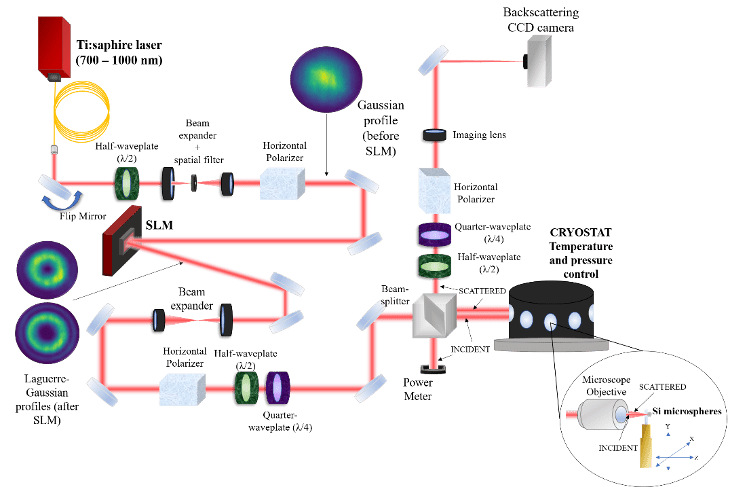During the inaugural meeting of the FASLIGHT network, a poster session was held, showcasing some of the research projects undertaken by the doctoral students from various nodes within the network. Below are the abstracts and information about the authors for each of the presented works.
Benjamín Alonso, Miguel López-Ripa, Cristian Barbero, Ignacio López-Quintás, and Íñigo Sola
Grupo de Investigación en Aplicaciones del Láser y Fotónica, Departamento de Física Aplicada, Universidad de Salamanca, Pl. Merced s/n, E-37008 Salamanca, – Spain
Unidad de Excelencia en Luz y Materia Estructuradas (LUMES), Universidad de Salamanca, Pl. Merced s/n, E-37008 Salamanca – Spain
In this work, we present some of the capabilities of the ALF group to produce and characterize singular beams as those present in structured light. In the first place, we present the STARFISH technique with polarization resolution (two-fold spectral interferometry based on a fibre optic coupler interferometer and in bulk interferometry), which is applied to space-time polarization shaped beams. Such beams are created by advanced shaping combining structured waveplates and standard polarization retarders. Both collimated and focused beams are reconstructed. In the second place, we present the BLASHI technique (bulk lateral shearing interferometry), applied to the spatiotemporal measurement of a beam with time-dependent orbital angular momentum, which is monitored thanks to its experimental reconstruction.
Víctor Arroyo, Carolina Romero and Javier R. Vázquez de Aldana
Aplicaciones del Láser y Fotónica, Universidad de Salamanca, Spain
Unidad de Excelencia en Luz y Materia Estructurada (LUMES), Universidad de Salamanca, Spain
In this work, we describe thedesign,fabrication and characterization ofsurface waveguide in a Nd:YAG crystal by direct femtosecond laser pulses writing. The development of this techniqueof writinghas allowed the fabrication of complex photonic circuits, which can be used in different scientific fields, such as Astrophotonics, Biomedicine or optical sensing.
The surface waveguides are based on depressed-index cladding and the aim of theseis to increase the area of interaction of the light confined in the device with the surface, while maintaining a controlled single-mode propagation profile, so that it can interact with the environment, detecting small changes in the surrounding conditions.The possibility of integrating these waveguides into any crystal allows to increase the functionality of photonic devices, due to the optical properties of crystalline materials.
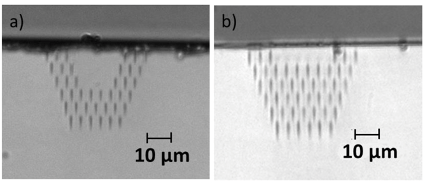
Figure 1: Optical microscopy image of ; entrance and b) exit sections, of a surface waveguide integrated in crystalline Nd:YAG.
Cristian Barbero1, Miguel López-Ripa1, Benjamín Alonso1,2, Íñigo J. Sola1,2
1Grupo de Investigación en Aplicaciones del Láser y Fotónica, Universidad de Salamanca, Salamanca, E-37008, Spain
2Unidad de Excelencia en Luz y Materia Estructuradas (LUMES), Universidad de Salamanca
Ultrafast laser science is experiencing a continuous growth. In this field, the development of light pulses temporal characterization techniques and setups has been a topic of interest for the last decades. Amplitude swing (a-swing) [1] is an ultrashort laser pulses characterization technique that stands out for its robustness and versatility [2]. Using the same simple, inline, and compact setup (Fig. 1), here we present two capabilities of this technique: the characterization of scalar pulses across different spectral regions [3] and the measurement of vector pulses [4].
For measuring at different spectral regions, a-swing is only limited by the transparency range of the optical elements and the phase matching in the nonlinear crystal. In this study, we have measured pulses from 620 to 1550 nm with the same experimental setup, just tilting the BBO (second harmonic generation crystal). These pulses have been reconstructed using a differential evolution algorithm.
Vector pulses are those with time- (and frequency-) evolving polarization. A-swing is sensitive to these pulses using the same setup, codifying in a single trace the full information of vector pulses. To extract it, we have developed a reconstruction strategy based on several steps of the Levenberg-Marquardt algorithm. This strategy has been numerically and experimentally validated, measuring vector pulses generated by propagating linearly polarized pulses through different retarder plates.
To sum up, a-swing is a robust and versatile characterization technique, with a compact, simple, inline, and stable setup, being able to measure scalar and vector pulses, at different spectral regions, and with different bandwidths and durations.
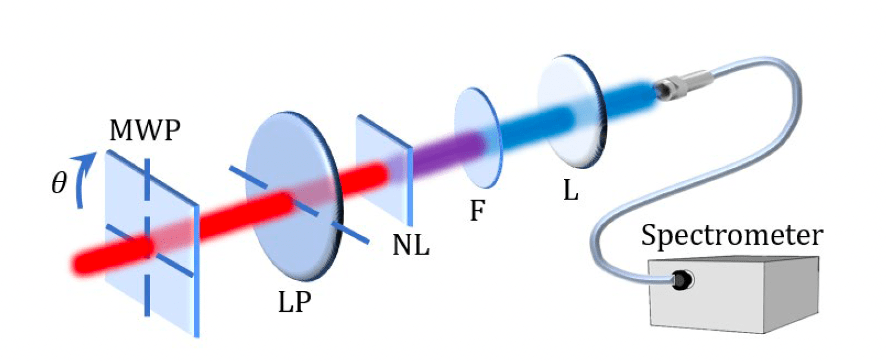
A-swing experimental setup: rotating multiple-order waveplate (MWP), linear polarizer (LP), nonlinear crystal (NL), filter (F) to remove the remnant fundamental signal, and convergent lens (L) to enhance the detected SHG signal.
References
[1] B. Alonso, W. Holgado, and Í. J. Sola, “Compact in-line temporal measurement of laser pulses with amplitude swing,” Opt. Express 28, 15625-15640 (2020).
[2] Í. J. Sola, B. Alonso, “Robustness and capabilities of ultrashort laser pulses characterization with amplitude swing,” Sci. Rep. 10, 18364 (2020).
[3] M. López-Ripa, Í. J. Sola, B. Alonso, “Amplitude swing ultrashort pulse characterization across visible to near-infrared,” Optics & Laser Technology 164, 109492 (2023).
[4] C. Barbero, B. Alonso, and Í. J. Sola, “Retrieving Ultrashort Pulses with Time-Varying Polarization Using Amplitude Swing”. Available at SSRN: http://dx.doi.org/10.2139/ssrn.4443101 (2023)
Ángel Cifuentes, Gabriel Molina-Terriza
Centro de Física de Materiales, Paseo Manuel de Lardizabal 5, 20018 Donostia-San Sebastián – Spain
Full control of the light field at the tip of the fibre holds the possibility of producing structured illumination patterns such as LG-beams or vector light fields which have important applications in quantum technologies [1] . Here, we show that by measuring the transmission matrix [2] we can obtain high-quality structured light, in the form of cylindrical vector beams, at the tip of three different few mode fibres (FMF) supporting ~6, ~12 and ~15 modes per polarization. We decompose the transmission matrix using SVD to assist in the shaping of the light at the fibre tip and show full control of the spatial distribution of not only the amplitude and phase of the output but also the polarization.
References
[1] R. Fickler, R. Lapkiewicz, S. Ramelow, and A. Zeilinger, ‘Quantum entanglement of complex photon polarization patterns in vector beams’, Physical Review A, vol. 89, no. 6, p. 060301, 2014.
[2] S. Popoff, G. Lerosey, M. Fink, A. C. Boccara, and S. Gigan, ‘Controlling light through optical disordered media: transmission matrix approach’, New Journal of Physics, vol. 13, no. 12, p. 123021, 2011.
Alba de las Heras,1,2 David Schmidt,3 Julio San Román,1,2 Javier Serrano,1,2 Daniel Adams,3 Luis Plaja,1,2 Charles G. Durfee,3 and Carlos Hernández-García1,2
1Grupo de Investigación en Aplicaciones del Láser y Fotónica, Departamento de Física Aplicada, Universidad de Salamanca, E-37008 Salamanca, Spain
2Unidad de Excelencia en Luz y Materia Estructuradas (LUMES), Universidad de Salamanca, Salamanca, Spain
3Department of Physics, Colorado School of Mines, Golden, Colorado 80401, USA
The landscape of ultrafast structured light pulses has greatly evolved thanks to the capability of high-order harmonic generation (HHG) to nonlinearly up-convert orbital angular momentum (OAM) from the infrared to the extreme ultraviolet/soft x-rays. Different works have shown the topological charge scaling with the harmonic order in HHG arising from the OAM conservation law, which has precluded the emission of vortex beams with attosecond pulse duration.
In this work, we demonstrate theoretically and experimentally a novel setup of HHG that produces harmonic vortices with the same topological charge as the driver. The noncollinear superposition of two circularly polarized vortex beams with opposite spin and OAM helicity creates a forked polarization tilt-angle grating at the generation plane. Then, the simultaneous conservation of linear momentum, spin, and orbital angular momentum yields two spatially separated circularly polarized high-harmonic beams with order-independent OAM. In the temporal domain, the synthesis of a comb of high-order harmonics with the same OAM results in an attosecond vortex pulse train, wherein the electric field describes spatiotemporal helicoids evolving over hundreds of attoseconds. This paves the way for the control of the orbital angular momentum of light at the attosecond timescale.
M.F. Galán, J. Serrano, E.C. Jarque, C. Hernández-García, and J. San Román
Grupo de Investigación en Aplicaciones del Láser y Fotónica, Departamento de Física Aplicada, Universidad de Salamanca, E-37008 Salamanca, Spain
High-order harmonic generation (HHG) constitutes a well-established tabletop source of high-frequency attosecond pulses, which offer great promise for advancing precision control of ultrafast dynamics at the atomic scale. In this work, we theoretically demonstrate a novel scheme for the compact and robust generation of extreme ultraviolet isolated attosecond pulses (IAPs) from HHG driven by infrared sub-cycle waveforms. Starting from a standard multi-cycle pulse, a light transient is generated by extreme soliton self-compression in a gas-filled hollow capillary fiber with a decreasing pressure gradient [1,2], and is subsequently used to drive HHG in a gas target. Owing to the sub-cycle confinement of the process, high-quality IAPs are directly emitted almost independently of the driver carrier-envelope phase, without the need of additional gating techniques [3]. Furthermore, soliton scaling laws allow for the generation of millijoule-level sub-cycle pulses with enough intensity to drive HHG at the fiber end, opening the way to a new generation of integrated all-fiber IAP sources.
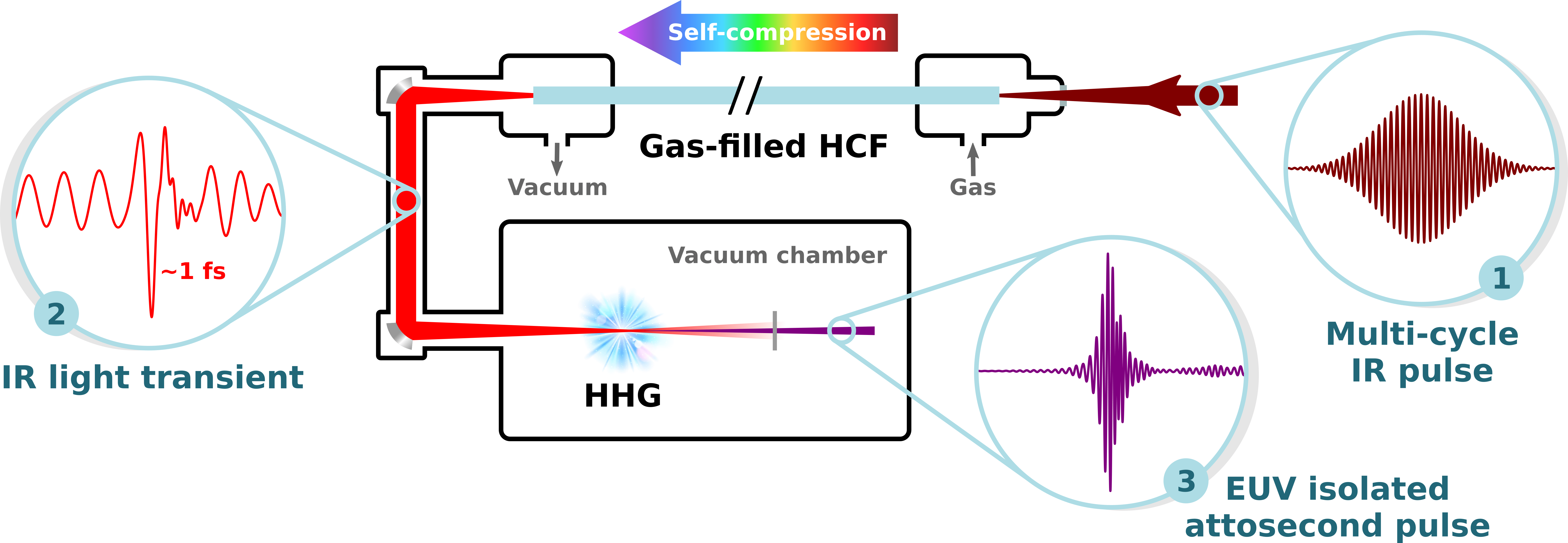
References
[1] J.C. Travers, T.F. Grigorova, C. Brahms, and F. Belli, “High-energy pulse self-compression and ultraviolet generation through soliton dynamics in hollow capillary fibers,” Nat. Photon. 13, 547 (2019).
[2] M.F. Galán, E.C. Jarque, and J. San Roman, “Optimization of pulse self-compression in hollow capillary fibers using decreasing pressure gradients,” Opt. Express 30, 6755 (2022).
[3] M.F. Galán, J. Serrano, E.C. Jarque, R. Borrego-Varillas, M. Lucchini, M. Reduzzi, M. Nisoli, C. Brahms, J.C. Travers, C. Hernández-García, and J. San Roman, “Robust isolated attosecond pulse generation with self-compressed sub-cycle drivers from hollow capillary fibers,” arXiv preprint, arXiv:2312.13321 (2023).
María García Alonso, Ángel Cifuentes , Jason Tarunesh Francis , Gabriel Molina Terriza
Centro de Física de Materiales, Paseo Manuel de Lardizabal 5, 20018 Donostia-San Sebastián – Spain
Here we propose an experimental scheme to implement a spatially-structured amplitude-squeezed light source, capable of interacting with small particles. Our ultimate goal is to realize quantum-enhanced measurement of the rotation of a gyroscope. A way to measure the rotation of a dielectric spherical particle is to check the frequency shift of the Mie coefficient resonances, which depend on the rotational velocity and the angular momentum of the incident field. This angular momentum can be controlled using structured light (i.e. Laguerre Gaussian modes). Our aim is to improve the measurements of those frequency shifts with a tunable quantum squeezed source.
Nilo Mata-Cervera1,2, Marcos García-Barriopedro1, Miguel A. Porras1
1Grupo de Sistemas Complejos, ETSIME, Universidad Politécnica de Madrid, Rios Rosas 21, 28003 Madrid – Spain.
2Institute of Materials Research and Engineering (IMRE), Agency for Science Technology and Research (A*STAR), 2 Fusionopolis Way – Singapore 138634
Exploding light beams and exploding vortex beams with orbital angular momentum are a family of paraxial beams with cylindrically symmetric intensity profiles that carry finite power and produce singular focal intensities when ideally focused, thus mimicking the behavior of focused plane waves but with finite power. We have realized them over finite apertures using amplitude and phase metasurfaces, and have observed the real-world manifestations of the singularity: boundless growth of the focal peak intensity and resolution power as the aperture radius increases. We show that exploding beams outperform the focusing capabilities of conventional Gaussian and Laguerre-Gaussian beams. Our design at a micrometric scale, and the control exercised by the aperture radius on the peak intensity, resolution power and vortex size, makes them potentially useful in applications where miniaturization is required, and to improve the performance and capabilities of optical tweezers and spanners.
Iker Gómez-Viloria, Alvaro Nodar, Martin Molezuelas-Ferreras, Jorge Olmos-Trigo,Angel Cifuentes, Miriam Martinez, Miguel Varga and Gabriel Molina-Terriza
Centro de Física de Materiales, Paseo Manuel de Lardizabal 5, 20018 Donostia-San Sebastián – Spain
Optical trapping is a well-established, decades old technology with applications in several fields of research. Since the first experiments showing the possibility of trapping particles using light, optical tweezers have been added to the toolbox of several research fields. For instance, optical tweezers are used in biology and have allowed the cooling of atoms to ultralow temperatures. The most common scenario deals with particles that tend to be centred on the brightest part of the optical trap. Consequently, the optical forces keep the particle away from the dark zones of the beam. However, this is not the case when a focused doughnut-shaped beam generates on-axis trapping. In this system, the particle is centred on the intensity minima of the laser beam and the bright annular part lies on the periphery of the particle. Researchers have shown great interest in this phenomenon due to its advantage of reducing light interaction with trapped particles and the intriguing increase of the trapping strength. This work presents experimental and theoretical results which extend the analysis of on-axis trapping with light vortex beams. Specifically, in our experiments, we trap micron-sized spherical silica (SiO2) particles in water and we measure, through the Power Spectrum Density (PSD) method, the trap stiffness constant κ generated by vortex beams with different topological charge orders. The optical forces are calculated from the exact solutions of the electromagnetic fields provided by the Generalized Lorentz-Mie Theory (GLMT). We show a remarkable agreement between the theoretical prediction and the experimental measurements of κ. Moreover, our numerical model gives us information about the electromagnetic fields inside the particle, offering valuable insights on the influence of the electromagnetic fields present in the vortex beam trapping scenario.
Mario Guerras1, Ignacio López-Quintás1, 2, Iñigo J. Sola1, 2
¹ Grupo de Aplicaciones del Láser y Fotónica (ALF), Universidad de Salamanca, Spain
² Unidad de Excelencia en Luz y Materia Estructurada (LUMES), Universidad de Salamanca, Spain
In the current investigation, we have conceived and implemented an optical system designed for the exploration of ultrafast fluorescence dynamics within the femtosecond and picosecond ranges, relying on an interferometer. Our methodology involves a first laser beam to induce the target signal within the sample, followed by a second laser beam that temporally probes the evolving signal. For this purpose, we use an optical switch that allows us to study the signal evolution. The intrinsic virtue of this technique lies in its ability to provide temporal resolution equivalent to the pulse duration of the second laser beam. In this study, we present the outcomes derived from the preliminary verification tests conducted to validate the efficacy and precision of the implemented system, representing a foundational step towards the comprehensive exploration of ultrafast fluorescence dynamics in subsequent phases of our scientific inquiry.
Erick Ipus1, Armin J. M. Lenz1, Jesús Lancis1, Alba Paniagua2, Pablo Artal2, Enrique Tajahuerce1
1GROC-UJI, Institute of New Imaging Technologies (INIT), Universitat Jaume I, 12071, Castelló – Spain
2Laboratorio de Óptica, Instituto de Investigación en Óptica y Nanofísica, Universidad de Murcia, E-30100, Murcia – Spain
We present a system for imaging objects through non-homogeneous scattering media that works in an adaptive way by combining diffuse optical imaging (DOI) and single-pixel imaging (SPI) techniques. To do that, first, the turbid media is characterized by projecting sinusoidal patterns using a programmable LED array as a light source and applying the spatial frequency domain imaging (SFDI) method. Secondly, the lower scattering areas of the turbid media were illuminated by reprogramming our light source. In parallel and simultaneously, the digital micromirror device projects the sampling patterns onto the object, codifying Walsh-Hadamard basis functions. The reconstructed images with our method, which combines two different optical imaging techniques in one experimental setup, show an enhanced quality when the illumination is adapted in contrast to random illumination is used.
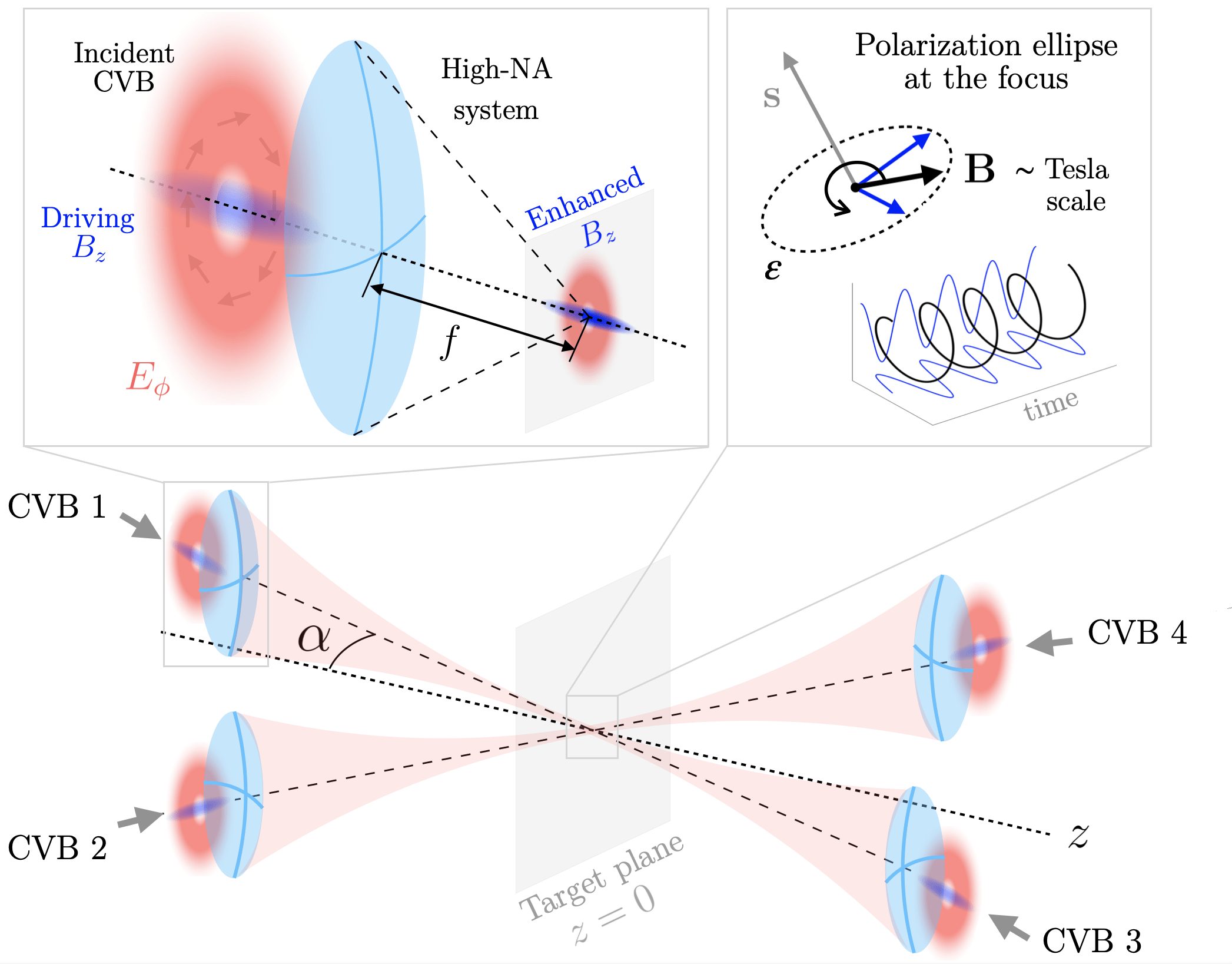
Rodrigo Martín-Hernández1,2, Miguel Ángel Porras3, Luis Plaja and Carlos Hernández-García1,2
1Grupo de Investigación en Aplicaciones del Láser y Fotónica, Departamento de Física Aplicada, Universidad de Salamanca, 37008, Salamanca – Spain
2Unidad de Excelencia en Luz y Materia Estructuradas (LUMES), Universidad de Salamanca, Salamanca – Spain
3Grupo de Sistemas Complejos, ETSIME, Universidad Politécnica de Madrid, Rios Rosas 21, 28003 Madrid, Spain
Longitudinal optical vortices have been extensively studied in the last 30 years [1], from its generation in the near infrared (IR) up to its conversion into high frequency, high-topological charge, vortices in the extreme-ultraviolet (EUV)/soft x-rays trough the highly non-linear process of high-order harmonic generation (HHG) [2]. However, recently another family of optical vortices, called transverse optical vortices or spatiotemporal optical vortices (STOV), have attracted lots of interest in the ultrafast and structured light community [3]. STOVs, unlike longitudinal optical vortices, are not propagation modes, revealing very interesting properties and new exciting scenarios.
In this work, we exploit the HHG process for the conversion of low-topological charge STOVs in the near-IR into the high-frequency regime. Surprisingly, we find two very differentiated scenarios, depending on how the driving near-IR STOV is focused [4]. In the first scenario, low-topological charge high-frequency STOVs are generated, where all the harmonic orders carry the same topological charge, which ultimately would lead to the possibility of STOV attosecond regime. In the second scenario, high-topological charge EUV STOVs are obtained, where the topological charge linearly scales with the harmonic order, following the same rule as in the up conversion of longitudinal optical vortices.[5]
References
- Shen, Y., Wang, X., Xie, Z. et al. Light Sci Appl 8, 90 (2019).
- Carlos Hernández-García, Antonio Picón, Julio San Román, and Luis Plaja Phys. Rev. Lett. 111, 083602 (2013)
- N. Jhajj, I. Larkin, E. W. Rosenthal, S. Zahedpour, J. K. Wahlstrand, and H. M. Milchberg Phys. Rev. X 6, 031037 (2016)
- Miguel A. Porras and Spencer W. Jolly arXiv:2309.01505 (2023)
- Rodrigo Martín-Hernández et al. In preparation.
C.Méndez, E. García, M. Olivar, I. Hernández, J.D. Pisonero, O. Varela, F. Glán, P. Zapatero, A. Vaquero, J. Pisonero, J.M. Pérez-Hernández and MD Rodríguez Frías
Centro de Láseres Pulsados Ultracortos Ultraintensos, Edif. M5, Parque Científico USAL, Villamayor Salamanca – Spain.
VEGA system is a user Petawatt research facility belonging to the Spanish Pulsed Lasers Center (CLPU). The facility is open to experiments devoted to explore the physics of linear and non-linear interactions of intense lasers with matter. The Ti:Sapphire Chirped Pulse Amplification (CPA)-based laser chain installed by Amplitude [1], was able to offer three common front-end outputs called VEGA 1,2,3. This configuration, as well as the installation of an additional 1kHz, 600 mJ, 6 fs carrier envelope phase system synchronized with VEGA laser chain, opens the possibility of multiple pump-probe experiments that are not routinely found in other facilities.
All over 2017, commissioning experiments for VEGA 2 [2] were developed before the first users’ competitive access (2018). These first experiments showed betatron radiation and TNSA protons generation [3]. VEGA 3 commissioning took place all over 2019 and users’ experimental time has been routinely developed since mid-year 2020.
In this work we present a review of the facility operational and reliability data as well as a summary of the result of the beamline reorganization project developed in the centre since 2020 [4] in order to offer pump & probe possibilities for all the laser lines shown in Figure 1.

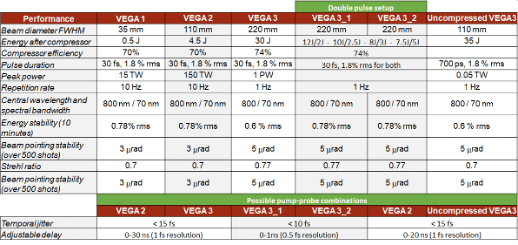
Figure 1. CLPU beamlines with Pump&Probe parameter possibilities
References
[1] https://amplitude-laser.com/
[2] M. Huault, et al., “Commissioning experiments of VEGA-2 at Centro de Láseres Pulsados (CLPU),” Frontiers in Optics. OSA Technical Digest (online) (Optical Society of America, 2017), paper FM2B.4.
Martín Molezuelas Ferreras, Álvaro Nodar, María Barra Burillo, Jorge Olmos Trigo, Jon Lasa Alonso, Iker Gómez Viloria, J. J. Miguel Varga, Elena Posada, Rubén Esteban, Javier Aizpurua, Luis Hueso, Cefe López y Gabriel Molina Terriza.
Centro de Física de Materiales, Paseo Manuel de Lardizabal 5, 20018 Donostia-San Sebastián – Spain
We present a novel optical technique for the characterization of single spherical particles. Relying on Mie Theory and its relation with the helicity of light, a regime is described in which the intensity of the back-scattering of micron-sized dielectric spheres shows an oscillatory pattern, that is experimentally found and analyzed to determine the refractive index of isolated spherical particles.
Mitzi Ordóñez-Pérez, Luis Ordóñez, Erick Ipus, Armin J. M. Lenz, Pere Clemente, Gladys Mínguez, and Enrique Tajahuerce
GROC-UJI, Institute of New Imaging Technologies (INIT), Universitat Jaume I, 12071, Castelló – Spain
This study introduces an innovative method to simultaneously measure the spatial profile and the spatially resolved temporal profile of a femtosecond laser beam, which combines structured compressive sensing illumination using spatial light modulators for spatial resolution and fringe-resolved autocorrelation for precise temporal resolution. Our experimental system integrates a digital mirror device (DMD) for structured light sampling with a single-pixel detector in a conventional autocorrelation configuration. To enhance efficiency, the approach incorporates intelligent algorithms for sampling, filtering, and specialized compressive reconstruction. To validate the setup, we developed a simulation of the autocorrelation process, which was subsequently verified experimentally. The results demonstrate the method’s efficiency, particularly in low-intensity systems.
Yago Radziunas-Salinas1, Bastián Carnero1, María Pita-Vilar2, Lucía Aboal-Castro2, Luis Antonio Díaz-Gómez2, María Teresa Flores-Arias1
1Grupo Photonics4Life. Departamento de Física Aplicada. iMATUS. Universidade de Santiago de Compostela (USC), 15782, Santiago de Compostela – Spain
2Grupo I+D Farma. Departamento de Farmacia y Tecnología Farmacéutica. iMATUS. Universidade de Santiago de Compostela (USC), 15782, Santiago de Compostela – Spain
In the last years, new techniques are being developed in medicine so as to provide more personalised attention as well as to improve the quality of life. One of the most interesting approaches at present is tissue engineering, where new device and methods are being created for the purpose of repairing, replacing, and regenerating damaged tissues and organs. Fast light seems to be a very promising technique for this end. It allows us to modify the surface of materials in a controlled way for enhancing their properties. Specifically, a femtosecond laser ablation is used in this work to improve the regenerative properties of a polycaprolactone (PCL) scaffold . It is able to perform high quality microtexturing, avoiding thermal effects and thus, the appearance of defects and stress at the material. In particular, a three-dimensional Scaffold tissue engineering platform for bone tissue regeneration was developed and characterised. It was fabricated by using 3D-printing techniques and its performance was improved by laser ablation with a femtosecond laser. The final microchannels on the fibres from the scaffolds were analysed with optical microscopy, confocal microscopy and computed tomography. Finally, an in vitro cell differentiation study of murine mesenchymal cells to osteoblasts was carried out, from which two results were obtained. On the one hand, a change in cell orientation during adhesion was observed as a consequence of micromachining in the fibres, enhancing their distribution in the direction along the structures performed at the surface with laser. On the other hand, it was reported that the cell density was higher in the micromachined scaffolds than in the control case.
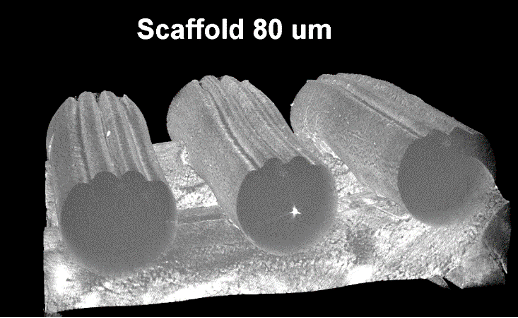
Micro-CT image of a fiber with 80 micron channel size

Comparison of preosteoblastic cells adhsesion on the Scaffold fibers according to the microchannel size.
Shah Jee Rahman1,2, Quimey Pears Stefano1, Gabriel Molina-Terriza1,2,3
1Centro de Física de Materiales, Paseo Manuel de Lardizabal 5, 20018 Donostia-San Sebastián – Spain
2Donostia International Physics Center, Paseo Manuel de Lardizabal 4, 20018 Donostia-San Sebastián – Spain
3 IKERBASQUE, Basque Foundation for Science, María Díaz de Haro 3, 48013 Bilbao – Spain
Optically levitated particles have a great potential to form the basis of novel quantum enhanced sensors. Researchers around the world are using them as a platform to study cutting-edge physics phenomena. These systems have been used to demonstrate force sensing up to 10-21N [1]. Optical levitation is very well suited for inertial sensing as the particles are completely isolated from thermal environment and have no particle-substrate interaction. In our setup we use a high numerical aperture objective lens to optically trap spheres in the direction of gravity. We cool the center-of-mass (CoM) motion of particles by modulating the intensity of the trapping beam in real-time by using an AOM (Acoustic Optical Modulator) [2]. The frequency-shifted trapping beam is then diffracted by a spatial light modulator (SLM) to create different orders of Laguerre-gaussian beams for trapping the particle in the centre of the beam or in the ring. Furthermore, we can control the rotational degree of freedom through the use of waveplates [3]. Rotors in the quantum regime exhibit strong interference effects that have no counterpart in the classical regime and no analogue in the CoM motion of the object. These rotors can be used to study rotational superpositions and next generation ultra-precise torque sensors [4].
References
- Liang, T., et al., Yoctonewton force detection based on optically levitated oscillator. Fundamental Research, 2023. 3(1): p. 57-62.
- Gieseler, J., et al., Subkelvin Parametric Feedback Cooling of a Laser-Trapped Nanoparticle. Physical Review Letters, 2012. 109(10): p. 103603.
- Jin, Y., et al., 6GHz hyperfast rotation of an optically levitated nanoparticle in vacuum. Photonics Research, 2021. 9(7): p. 1344-1350.
- Stickler, B.A., K. Hornberger, and M. Kim, Quantum rotations of nanoparticles. Nature Reviews Physics, 2021. 3(8): p. 589-597.
Víctor Wilfried Segundo Staels, Enrique Conejero Jarque and Julio San Román
Grupo de Investigación en Aplicaciones del Láser y Fotónica, Universidad de Salamanca, Pl. Merced s/n, Salamanca E-37008 – Spain
Multipass cells (MPCs) have emerged as a promising scheme for post-compression of ultrashort laser pulses [1]. While there has been an extended research on gas-filled and bulk-filled MPCs, the focus on achieving ultrashort pulses with a clean shape is still under study [2,3]. In this work we aim to obtain structureless and clean transform limited pulses. We perform numerical simulations in the (3+1)D including the most relevant non linear effects. In the Enhanced Frequency Chirp Regime, self-phase modulation and dispersion compete with each other, which allows a spectral broadening providing short and clean transform limited pulses [4]. To achieve this, various parameters are systematically modified to identify the best configuration, including cavity length, pulse energy, mirror curvature radius, and glass type, thickness, and position. We find that a favorable configuration is a cavity length of 40 cm, mirrors with a radius of 7.3 m, pulse duration of 150 fs, pulse energy of 220 μJ, and the use of 2 x 500 μm Fused Silica glass located on the mirrors. We let the pulse propagate 60 round trips in this cavity. This research establishes a region of parameters that leads to the clean compression of femtosecond pulses within an all-bulk MPC cavity, resulting in sub 20 fs clean transform limited pulses.
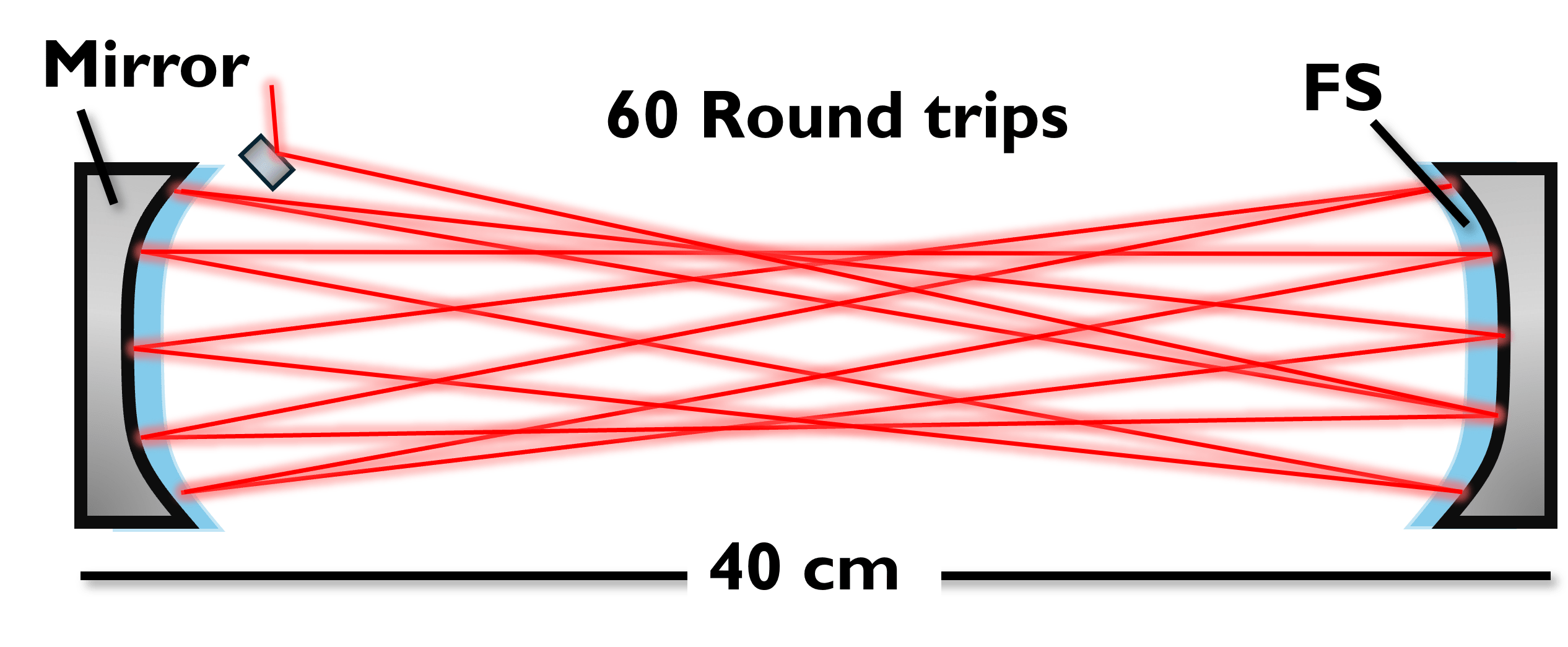
References
[1] A. L.Viotti et al; Optica, 9, 197 (2022).
[2] V. W. S. Staels et al; Opt. Express, 31, 18898 (2023).
[3] M. Benner et al; J. Opt. Soc. Am. B., 40, 301 (2023).
[4] W. J. Tomlinson et al; J. Opt. Soc. Am. B, 1, 139 (1984).
Javier Serrano1,2, José Miguel Pablos-Marín1, Carlos Hernández-García1,2
1Grupo de Investigación en Aplicaciones del Láser y Fotónica, Departamento de Física Aplicada, Universidad de Salamanca, Pl. Merced s/n, E-37008 Salamanca, – Spain
2Unidad de Excelencia en Luz y Materia Estructuradas (LUMES), Universidad de Salamanca, Pl. Merced s/n, E-37008 Salamanca – Spain
High harmonic generation (HHG) stands out as a complex phenomenon within the realm of strong-field physics. This process facilitates the conversion of laser light originating in the infrared spectrum into extreme-ultraviolet or soft x-rays, enabling the synthesis of laser pulses with durations as brief as tens of attoseconds. Precisely simulating such a profoundly nonlinear and non-perturbative process involves integrating the laser-driven wavepacket dynamics, as dictated by the three-dimensional time-dependent Schrödinger equation (3D-TDSE), with the Maxwell equations to account for macroscopic propagation. Running these calculations presents a formidable challenge, surpassing the capabilities of current computational technology. As a result, approximations such as the strong field approximation become necessary. In our study, we demonstrate that harnessing the power of machine learning, specifically leveraging deep neural networks, offers a viable avenue for simulating macroscopic HHG within the framework of the 3D-TDSE. This approach reveals hidden signatures in the attosecond pulse emission that are neglected by conventional approximations. Our HHG method, enhanced by artificial intelligence, proves particularly adept at simulating the generation of structured attosecond pulses in the soft x-ray spectrum.
Nuria Sevilla-Sierra1,2, Javier Rodríguez Vázquez de Aldana1,2, Carolina Romero1,2, Xavier Mateos3, Ignacio López-Quintas1,2
1Grupo de Investigación en Aplicaciones del Láser y Fotónica, Universidad de Salamanca, Pl. La Merced SN 37008 Salamanca, Spain
2Unidad de Excelencia en Luz y Materia Estructurada (LUMES), Universidad de Salamanca, Spain
3Física i Cristalografía de Materials (FiCMA), Universitat Rovira i Virgili (URV), 43007 Tarragona, Spain
Ultrashort laser pulses can micro-structure transparent solids by locally modifying, with high spatial precision, the index of refraction. Second Harmonic Generation Microscopy is based on the principle that SHG only occurs in non-centrosymmetric materials with non-vanishing second order susceptibility; and only on the focal region of the focused laser beam. In this work we have investigated the nonlinear response of two different previously micro-structured crystals. The first one is a BBO non-linear crystal, in which we have found second harmonic generation in extraordinary polarization conditions. This is due to a modification via micro-structuring of the effective nonlinear coefficients of the susceptibility tensor. The second studied crystal is a Nd:YAG centrosymmetric one. The dislocated or amorphized regions obtained by irradiating with femtosecond pulses imply a breakage of the symmetry, enabling the creation of localized second-order nonlinear response thus generating second harmonic. This opens the possibility of waveguide or integrated photonic devices fabrications in centrosymmetric materials that are not initially expected to have a nonlinear response.
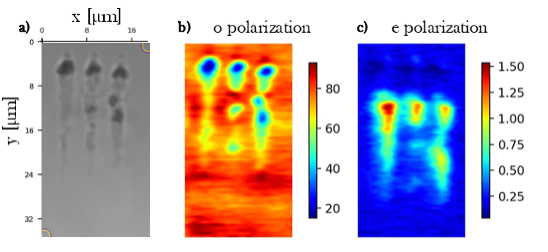
Figure 1: a) Optical image of micro-processed area inside a BBO crystal. b) SHG map obtained with laser in ordinary polarization. c) SHG map obtained with extrordinary polarization of the measuring laser beam.
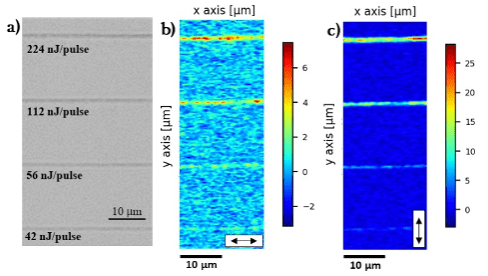
Figure 2: a) Optical image of micro-processed area inside a Nd:YAG crystal. b) SHG map obtained with laser in horizontal polarization. c) SHG map obtained with vertical polarization of the measuring laser beam.
I. Tribaldo Ramírez, M. Molezuelas Ferreras, A. Cifuentes, M. Varga, G. Molina Terriza.
Centro de Física de Materiales, Paseo Manuel de Lardizabal 5, 20018 Donostia-San Sebastián – Spain
The scattering of light by microscopic particles has been a continuously intriguing topic in optics and particle physics. In this study, we investigate the behaviour of the light backscattering spectrum in microspheres, a highly relevant system due to its significance in applications ranging from atmospheric particle detection to the characterization of nanomaterials.
Our investigation is based on Mie’s theory, which describes the interaction of light with spherical particles. We employed carefully selected dielectric microspheres with diverse diameters in the micrometer range and a monochromatic light source to originate the scattering phenomena. We collect the backscattering light and recorded the image of its intensity profile with a camera. The sum of the pixels corresponds to the backscattered power. Repeating the process for different wavelengths, we obtain the backscattered spectrum of the spherical microspheres (see Figure 1 for a scheme of our optical setup).
The results unveiled structured backscattering patterns directly correlated with the properties of the microsphere, such as its size and refractive index. For larger-sized particles, the observed backscattering spectrum closely mirrored the theoretical results based on the Mie’s theory. Our aim is to apply the same experimental setup to smaller optical-sized particles, where the renowned Mie resonances can be observed. The ongoing research with silicon particles is yielding promising results in accordance with theoretical simulations (see Figure 2 for an example of the evolution of the backscattered field with the wavelength and a comparison with theoretical results).
Our study contributes to a deeper understanding of light scattering phenomena in spherical particles and demonstrates the potential of Mie microspheres as versatile tools in advanced optical applications. The obtained results may offer significant perspectives for future research in the field of particle optics and nanotechnology.
We demonstrate how to implement root systems of arbitrary order of the Su-Schrieffer-Heeger (SSH) model in photonic ring resonator setups, focusing in particular in the third root. The root systems generated by this method are Topological Insulators (TIs) by all rights, but they require the existence of unidirectional couplings to be implemented, which makes them non-Hermitian. The building blocks of the implementation are a set of resonant main rings coupled through antiresonant link rings with a split structure. The upper optical path of these link rings displays gain, while the lower half displays an equal amount of loss. This yields an asymmetric coupling which reproduces the needed unidirectionality.
Gil de Oliveira1, A. L. S. Santos Junior1, A. C. Barbosa1, B. Pinheiro da Silva1, G. H. dos Santos2, G. Cañas3, P. H. Souto Ribeiro2, S. P. Walborn3, and A. Z. Khoury (1)
1Universidade Federal Fluminense – Brazil
2Universidade Federal de Santa Catarina – Brazil
3Universidad de Concepción – Chile
We investigate theoretically and experimentally the optical second harmonic generation (SHG) with a twisted Gaussian Schell model (TGSM) beam as the fundamental field. We use Type-II phase matching and analyze the cross spectral density (CSD) of the SHG output beam when the input fundamental is prepared with a TGSM structure. We analyze two synthetization methods for preparing the TGSM fundamental beam and we find that for one method the SHG is also a TGSM beam. For the other method, we find that the SHG is not a TGSM beam and presents an anomalous CSD possessing a dip instead of a peak in the transverse spatial structure. Moreover, we show that the dip depth is directly related to the twisted phase parameter, being absent for a non twisted GSM beam. Our results show that the SHG from a fundamental TGSM beam can result in a doubled frequency TGSM or in a non-TGSM beam depending on the synthetization method.
